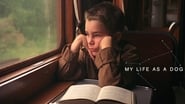classicsoncall
I didn't know what to expect with this story. Initially, it appears that young Ingemar (Anton Glanzelius) is merely a mischievous troublemaker, but inwardly, he harbors all the self doubt and insecurity of any young boy his age, compounded by a terminally ill mother and a brother with whom he has very little connection. However Ingemar has a way of disengaging from his troubles by comparing his life with outcomes experienced by those even more less fortunate. Despite a rebellious nature, his introspection allows him to foster a positive attitude which I found quite remarkable, especially while ruminating on the fate of Laika, the Russian space dog that died while on a mission for the Soviets. His thoughts are decidedly more existential than most kids of his age and serve as a coping mechanism for the eventual passing of his mother that the film leads us toward. The youngster portraying Ingemar seems a natural talent, though his filmography here on IMDb is quite limited. His sidekick Saga (Melinda Kinnaman), looking every bit the tomboy, affected a wonderful transformation so that by the end of the picture, it was visually jarring to see her looking pretty in a dress. Their coming of age story is portrayed sweetly with innocence, and though the film explores sexual themes with it's eccentric characters, it does so maturely with a young person's sense of wonder and amazement.
bandw
Ingemar is on the cusp of adolescence. It is the late 1950s Sweden. When the opening scene showed Ingemar on the beach amusing his mother with some childish antics, I was primed for a happy coming-of-age story. But then it is revealed that Ingemar is living at home with his mother who has tuberculosis. This sets the theme of the movie, just when you think things might be looking up for Ingemar, darker issues arise.Anton Glanzelius, who plays Ingemar, embodies a perfect combination of imp and winsomeness. He can cause adults grief with his trouble-making, but much of the time it is his innocence that gets him into trouble, like the time he has a small fire going in a trash dump that gets out of control, or the time he is suckered into an embarrassing prank at school. He has some odd behaviors, like approaching his milk glass with trepidation as if were one of life's great challenges to drink from it.When Ingemar becomes too much for his mother to handle he is sent to a small village down south to live with his uncle's family. This village has more than its share of eccentrics, like an older guy who is constantly repairing his roof, or the uncle's father who asks Ingemar to read to him from the lingerie section of a catalog. Much of the footage at the uncle's is gentle humor interspersed with typical trials of growing up. But then the mother dies. And so it goes.Ingemar has a delightful philosophical bent. As one way to deal with life's challenges he frequently tries to comfort himself by thinking that things could be worse. He keeps meditating on Laika, the dog that the Soviets sent into space in 1957, the first living animal sent up. In thinking of Laika, Ingemar comments, "You have to compare, so you can keep perspective. It helps to keep a little distance." He frets over the thought that Laika was sent into space knowing that he would most certainly starve to death. Maybe Ingemar sensed a wider metaphorical meaning--in some sense we are all shot into space at birth only ultimately to suffer the fate of certain death. The main musical theme perfectly captures the melancholic mood; its memory is one of the things that drew me to re-watch this after having first seen it over twenty years ago.
TheLittleSongbird
I had high expectations for My Life as a Dog, and not only did the film meet those expectations it also surpassed them.I was really taken with the emotional core My Life as a Dog had. The scenes where Ingemar gets into mischief are fitfully amusing, but other scenes are very poignant too. I think some of the emotional resonance of the film comes from how truthful and warm My Life as a Dog is, there's even something very Truffautesque about it.My Life as a Dog has an evocative script, a compelling story and characters that feel real, you immediately connect with Ingemar and do so right up to the last second.Lasse Hallstrom directs beautifully, the film looks gorgeous in photography and production values, the score is haunting and Anton Glanzelius's lead performance is astonishing combining charm and wit with innocence and spirit.Overall, a truly wonderful movie. 10/10 Bethany Cox
Lee Eisenberg
After I had seen "The Cider House Rules" and "Chocolat", I took some interest in Swedish-born director Lasse Hallstrom, and so I decided to check out one of his movies from his native country. "Mitt liv som hund" ("My Life as a Dog" in English) really impressed me. This story of abandoned boy Ingemar hits the perfect balance between sentimental and gritty, with one scene that was probably there for a little comic relief (you'll know what I mean if you see the movie). Probably the most effective scene is when Ingemar talks about Laika, the Soviet space-dog. Just as happened to Laika, Ingemar didn't want to have to go through this, it was done to him. And both Laika and Ingemar got left in limbo. Both were victims of cold, abstract forces.Anyway, this is definitely one that I recommend. In my opinion, Hallstrom's American movie most like this one was "What's Eating Gilbert Grape", about a destitute family in Iowa. Both are worth seeing.






